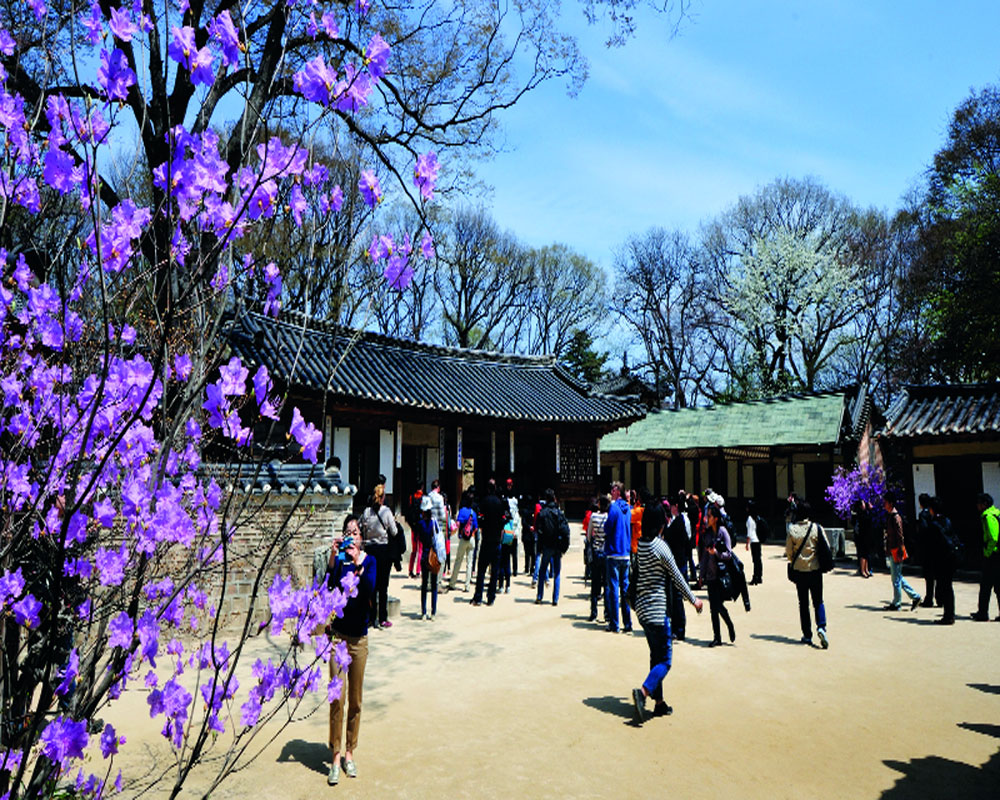On the Trail of Buddha — A Journey to the East by Deepankar Aron is a unique sojourn in search of the spiritual, philosophical, and cultural linkages that bind India to the East Asian civilisations. It discovers the unity in diversity of cultures connected by two thousand miles of the Silk Road and separated by two thousand years of history. An edited excerpt:
The traditional Korean greeting Anyeong hasseyo means ‘Are you peaceful?’. Indeed, there is not one, but many a unique experience and peaceful encounters that can define the wonderful Korean experience.
I was ruminating on the three giant gold-plated Buddha statues at the Jogyesa Temple, wondering at the calm and tranquillity they exuded, even after 2600 years of Buddha’s nirvana, when a monk passing by stopped with a smile on his face and asked, ‘Are you Indian?’ Soon he presented his card — he was a Doctorate in Religious Studies.
JOGYESA
I was at Jogyesa, the main Buddhist temple in Seoul, which belongs to the leading sect of Buddhism in Korea called the Jogye Order. Known as Chan Budhism in China and Zen Buddhism in Japan, it came to Korea from China, about 1200 years ago, when the Korean master, Taego Bowu went to China and became the 57th Patriarch of Buddhism and the first in Korea. He followed the teachings of the Ist Patriarch of China, the Indian monk Bodhidharma or Damo, who in turn was the 28th Indian Patriarch. Today, close to 20,000 monks and 20 million people in Korea follow this order. The temple, the biggest in Seoul today, was expanded in a big way in 1938 by adding the main wooden hall, Daeungjeon, which houses three giant images of the Amitabha, the Historical Buddha and the Medicine Buddha.
For a temple as large as this, it was conspicuously quiet. People were silently offering prayers, sitting over mats spread on the floor of the main hall. An elderly lady saw me and offered to take my photo from my camera without my having suggested so. I took hers too, reciprocating her warmth and affection.
Modern Seoul is vibrant with fashionable young professionals who believe in the work-hard-play-hard culture. Notwithstanding the absence of fluency in English, their business-like approach manifests in various ways — be it the 22000 USD per capita GDP, which was less than USD 100 in 1953; the meteoric rise of South Korean economy, which is Asia’s third-biggest economy today, or the legendary emergence of not just Hyundai or Samsung brands, but so many others. It could be felt in the interactions with any Korean — from the presentations of my Korean Custom department friends to the absolute professional homework of the tour guide, who took us on a tour of the World Heritage Site of Gyeongbokgung Palace. For example, to explain the concept of ‘ondeol’, the traditional heating system of Korean homes, our tour guide drew out a proper schematic diagram to show the generation of heat and the consequent hot air and its movement under the floor made up of stones and clay.
Seoul is fast emerging as the ‘New Design Capital’ of the world, sprinkled with art galleries at every nook and corner of the city, with multi-storeyed markets selling artistic souvenirs, museums, and handicraft shops giving workshops on pottery making, etc. Artists can be seen making live paintings while music waft from the streets where performers play. The cynosure of this ‘Designer Seoul’ is the Cheonggyecheon, a lovely stream with a beautiful promenade running along with it. More than 8 km long it was recreated in downtown Seoul after demolishing buildings that covered a stream that used to flow there in the past as well.
GYEONGBOKGUNG PALACE
The colours of Korea can be best savoured during the hourly ‘change of guards’ ceremony at Gyeongbokgung Palace, bringing alive the glory of 600 years of Joseon rule, until about the last century. The colourful guards stand in sharp contrast to the serenity of the palace and its simple architecture. Hanyang (old name of Seoul) was chosen as the capital of Joseon dynasty (1392-1910), as per fengshui, because it was surrounded by four mountains in the four directions.
The best example of traditional ‘Joseon Korea’ for me was the Bukchon Hanok village with hundreds of traditional Korean houses or hanoks, with a central courtyard, like the hutongs of Beijing or the traditional houses of India. We loitered, drifted and lost our way again and again in its narrow alleys while staring at the ever-changing compositions of rooftops, doors, and sloping alleys, framed by a riot of cherry blossoms.
Korea has become a developed country, but that has not taken away the warmth and hospitality of the Koreans. The fight to pick up the bill with Joon, my local Korean friend, or the touching gesture of Mr Jang bringing me Korean coins for my collection, shall linger on forever.
As I leave Seoul, I hope to visit it in future at the time of the Yeon Deung Hoe or the Lotus Lantern festival, celebrated annually, a few days prior to Buddha’s birthday, when hundreds of thousands of lanterns are lit up and carried in an evening procession from Dongdaemun (Great Eastern Gate of the Seoul Fortress) to Jogyesa — a 1300-year-old tradition, dating from the times of the Silla dynasty.
Excerpted with permission from On the trail of Buddha: A Journey to the East by Deepankar Aron, Niyogi Books, Rs 1,995


























